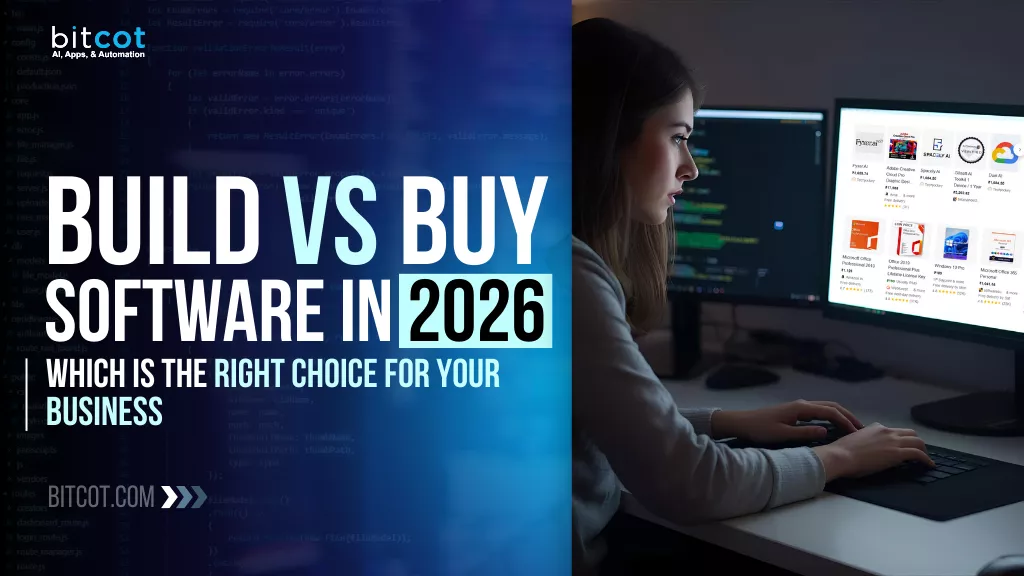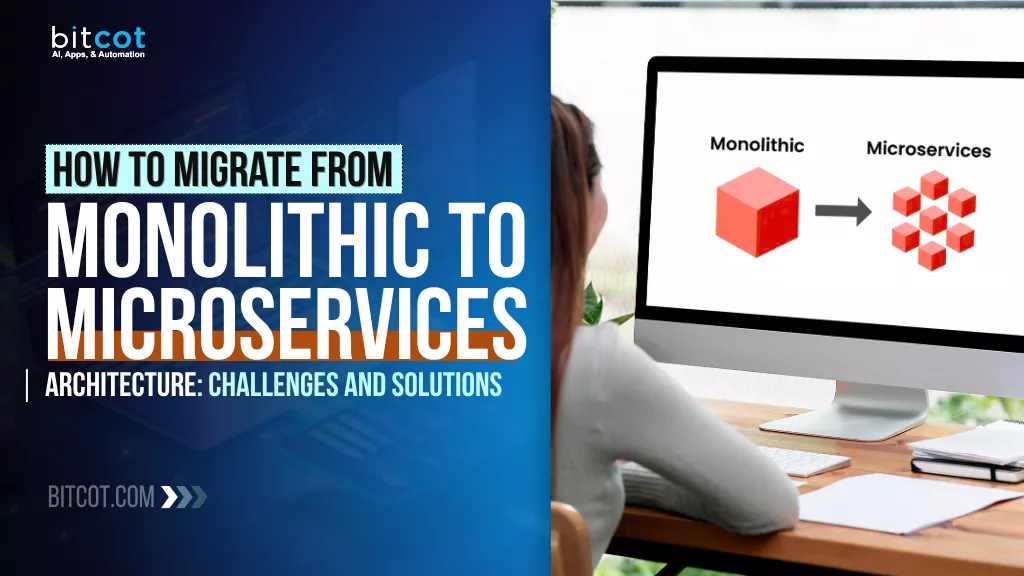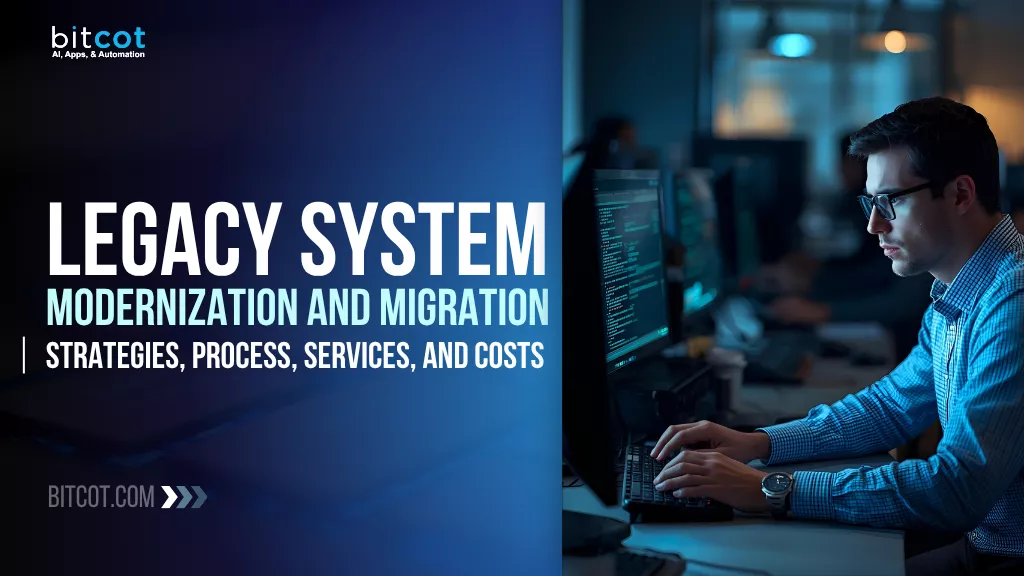
If your business is still running on software that feels like it belongs in a museum, you’re not alone.
Legacy systems, those old, outdated applications that have been keeping your operations ticking for years, can feel like both a blessing and a curse.
On one hand, they’ve reliably handled your processes for decades; on the other, they’re slow, inflexible, and increasingly difficult to maintain. As technology evolves at lightning speed, relying on legacy systems can hold your business back, causing inefficiencies, security risks, and missed opportunities for growth.
That’s where legacy system modernization and migration comes in.
Think of it as giving your business the digital upgrade it desperately needs, without losing the data, processes, or workflows you’ve built over the years.
Whether it’s moving to the cloud, adopting newer software architectures, or completely reimagining your systems, modernizing your legacy infrastructure can unlock agility, reduce costs, and make your business more competitive.
From tech giants in San Francisco and San Jose to financial institutions in Los Angeles and healthcare organizations in San Diego, businesses across California and the broader USA are recognizing that digital transformation is no longer optional.
In this blog, we’ll walk you through everything you need to know: the strategies that work, the step-by-step modernization process, the types of services available, and the costs you can expect.
If you’ve been wondering whether it’s time to retire your old systems or how to do it without disrupting your business, you’re in the right place.
Let’s dive in and explore how to make your technology future-ready.
How to Identify If Your Software Is a Legacy System
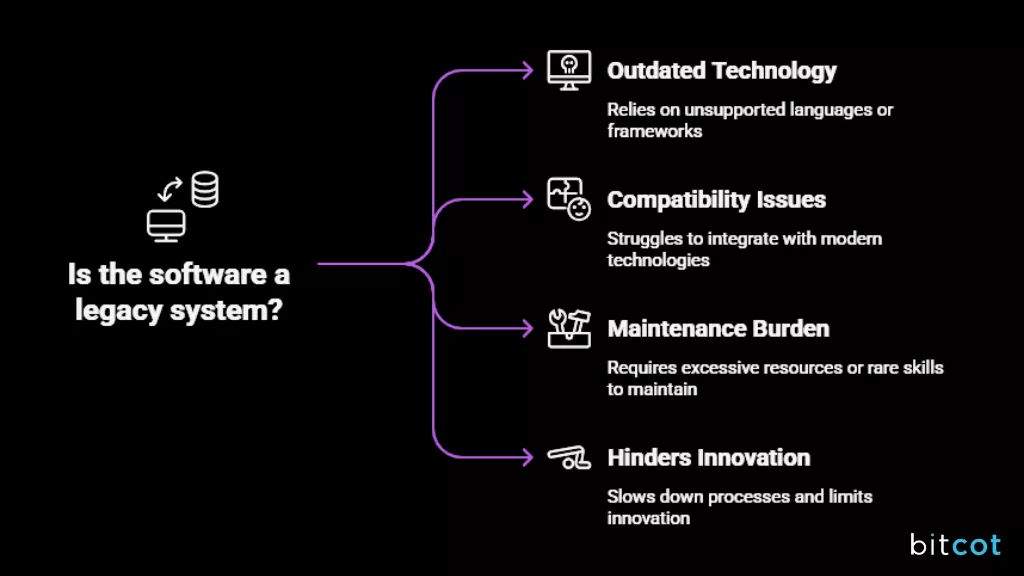
Not every old system qualifies as a legacy system, but if your software is starting to feel more like a roadblock than a helpful tool, it’s worth taking a closer look.
Legacy systems are those older applications or platforms that your business has relied on for years, or even decades, but that no longer meet the needs of your current operations. They may still work, but they often come with hidden costs, risks, and inefficiencies.
Here are some telltale signs that your software might be a legacy system:
- It’s slow, clunky, or unreliable: Processes that should be quick take forever to complete. Crashes, downtime, or lag are becoming a common part of your workflow rather than an exception.
- Difficult to maintain or update: Updates are rare or complicated. Developers who understand the old technology are hard to find, and even minor changes can break other parts of the system. Companies in Sacramento and Fresno often struggle to find talent with expertise in outdated programming languages.
- Incompatible with modern tools: Integration with new software, cloud platforms, or automation solutions is difficult or impossible, which limits your ability to innovate.
- High operational costs: Keeping old hardware running, paying for outdated licenses, or relying on specialized support can quickly become expensive.
- Security vulnerabilities: Legacy systems often don’t receive security patches or updates, leaving your data and your business exposed to threats. This is particularly concerning for businesses in Long Beach and Oakland that handle sensitive customer information.
- User frustration: Employees or customers struggle with outdated interfaces or inefficient workflows, which can slow productivity and damage satisfaction.
- Limited scalability: As your business grows, the old system struggles to keep up with increasing data, users, or transaction volumes. Growing businesses in Bakersfield and Anaheim frequently encounter these limitations.
If you see yourself nodding along with even a few of these points, it’s a clear signal that your software is holding you back.
The good news?
Recognizing the problem is the first step toward legacy system replacement. Once you understand that your system is legacy, you can start exploring strategies to upgrade, migrate, or even completely reimagine your technology infrastructure, without disrupting your business operations.
Benefits of Legacy System Modernization and Migration
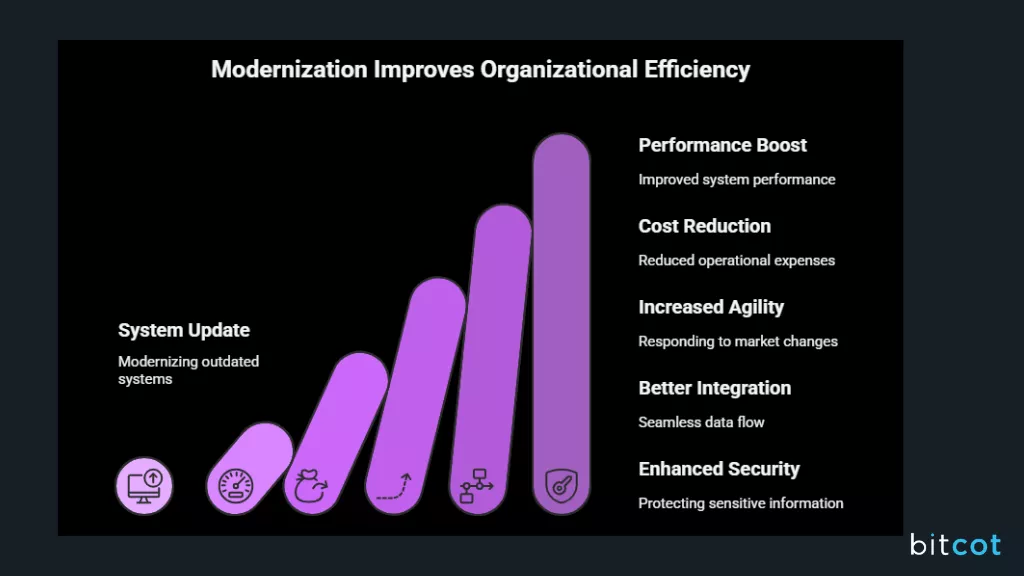
Modernizing or migrating a legacy system isn’t just about updating software; it’s about transforming the way your business operates. It touches everything from efficiency and security to scalability and innovation.
While the idea of modernizing an old system may feel daunting, the benefits are often substantial and long-lasting. Organizations throughout California, USA, from Riverside to Stockton and Santa Ana, are discovering that modernization unlocks competitive advantages previously constrained by outdated technology.
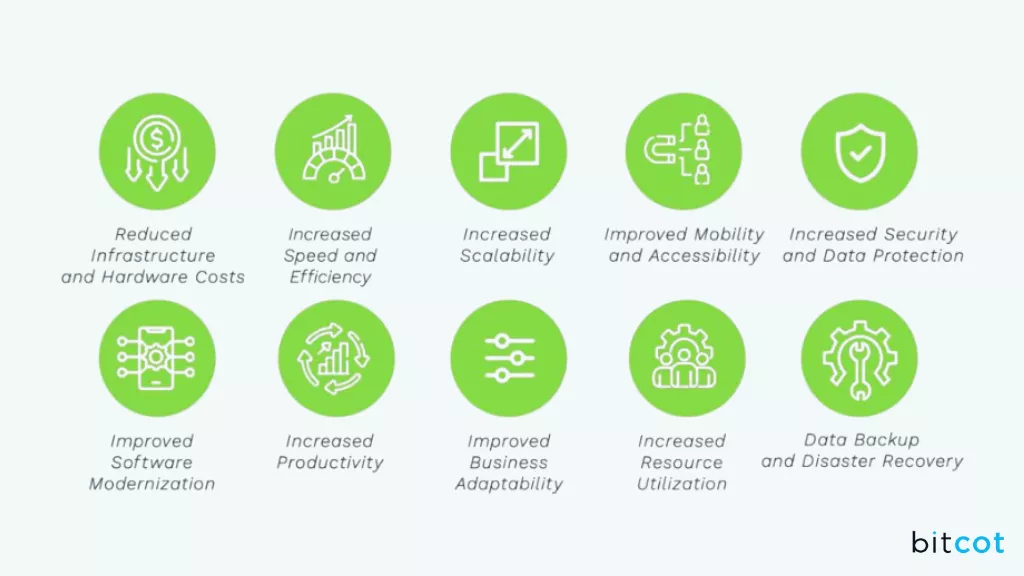
Let’s break them down in detail:
Enhanced Operational Efficiency
Legacy systems often involve manual processes, duplicate efforts, and cumbersome workflows. Modernization streamlines these operations, automates repetitive tasks, and minimizes errors. Employees spend less time wrestling with outdated software and more time focusing on high-value activities, which boosts productivity and allows your business to move faster.
Seamless Integration with Modern Tools
Older systems usually struggle to connect with modern applications, cloud platforms, and analytics tools. A modern system enables smooth integration across your software ecosystem. This means better data flow, more efficient workflows, and the ability to leverage advanced technologies like AI and automation without starting from scratch.
Significant Cost Savings
Maintaining legacy systems can be surprisingly expensive. Outdated hardware, specialized support, and legacy software licenses all add up over time. Modernization reduces these costs by moving to more efficient platforms, cloud solutions, or scalable architectures. While there’s an upfront investment, the long-term savings and improved efficiency usually outweigh the initial expenditure.
Businesses in Irvine and Chula Vista have reported substantial cost reductions after successful modernization projects.
Improved Security and Compliance
Legacy systems often lack critical security updates and are vulnerable to breaches. Modern platforms come with up-to-date security features, automated patching, and compliance-ready frameworks. This reduces the risk of data breaches, protects sensitive information, and ensures your business meets industry regulations more easily.
Scalability for Growth
A major limitation of legacy systems is their inability to scale as your business grows. Modern systems are built with scalability in mind. Whether you’re handling more data, more users, or expanding into new markets across California and the USA, upgraded platforms can adapt to your growing needs without compromising performance.
Better User Experience
Outdated interfaces and slow performance frustrate both employees and customers. Modern systems offer intuitive designs, faster response times, and smoother interactions, which improve satisfaction, adoption rates, and overall engagement. A system that’s easier to use encourages efficiency and reduces the learning curve for new employees.
Agility and Innovation
Modernized systems make it easier for your business to adapt to change. Whether it’s adopting new technologies, responding to market shifts, or experimenting with innovative solutions, a flexible system allows your organization to remain agile. This opens up opportunities for continuous improvement and keeps you ahead of competitors.
Future-Proofing Your Business
Legacy system modernization isn’t just about fixing current issues; it’s about preparing for the future. With a modern infrastructure, your business is ready to adopt emerging technologies like AI, machine learning, advanced analytics, and cloud solutions. It sets the foundation for growth, innovation, and long-term competitiveness.
Real-World Examples of Legacy System Modernization
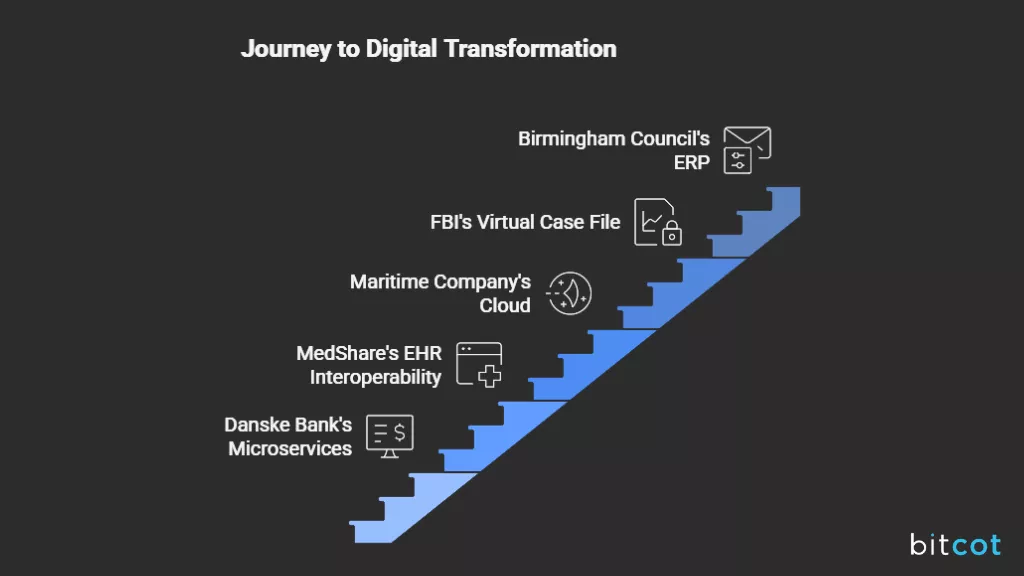
Understanding the real-world impact of legacy system modernization is crucial.
Let’s explore some notable case studies that highlight both successful digital transformations and cautionary tales.
Success Story: Danske Bank’s Microservices Migration
Danske Bank, one of Denmark’s largest financial institutions, faced challenges with its monolithic architecture. The bank embarked on a legacy system migration to microservices, aiming for scalability and agility. This transition allowed them to:
- Enhance scalability: The new microservices architecture enabled the bank to scale individual components as needed.
- Improve resilience: By decoupling services, the system became more resilient to failures.
- Accelerate development: Teams could work on independent services, speeding up development cycles.
This modernization effort positioned Danske Bank to better meet the demands of the financial sector and respond swiftly to market changes.
In the healthcare sector, legacy Electronic Health Record (EHR) systems often hinder data sharing between institutions. MedShare addressed this by creating an integrated architecture that:
- Extracted data from existing EHR systems.
- Converted it into a common data model.
- Enabled secure data exchange among hospitals.
This approach improved patient care by facilitating data sharing while ensuring compliance with privacy regulations. Similar initiatives are being adopted by healthcare systems in San Diego and Los Angeles, California, to improve patient outcomes.
Failure Case: FBI’s Virtual Case File (VCF)
The FBI’s Virtual Case File project, initiated in the early 2000s, aimed to modernize its case management system. However, the project faced significant challenges:
- Scope creep: The project’s scope expanded beyond initial plans, leading to delays.
- Technical issues: The system encountered numerous technical problems, including inadequate design and lack of essential features.
- Budget overruns: The project exceeded its budget, costing taxpayers nearly $170 million.
Ultimately, the VCF project was abandoned, and the FBI had to revert to its legacy system, highlighting the risks of poorly managed modernization efforts.
Failure Case: Birmingham City Council’s ERP Overhaul
Birmingham City Council undertook a project to replace its SAP ERP system with Oracle Cloud ERP. The modernization effort encountered several issues:
- Resistance to change: The council insisted on maintaining legacy workflows, leading to a misalignment with the new system’s capabilities.
- Cost escalation: The project’s cost ballooned from £38 million to £114 million.
- Operational setbacks: Finance processes regressed to manual methods, undermining the project’s objectives.
This case underscores the importance of aligning new systems with modern processes and being open to change during modernization.
Success Story: Maritime Company’s Cloud Automation
A maritime company with outdated infrastructure faced challenges in maintaining system reliability. By modernizing their systems, they achieved:
- Automation of infrastructure: Reduced manual interventions by up to 30%.
- Enhanced system reliability: Decreased system failure rates by 35%.
- Cost optimization: Achieved a 25% reduction in cloud costs.
This modernization not only improved operational efficiency but also delivered tangible financial benefits.
Effective Strategies for Successful Legacy System Modernization
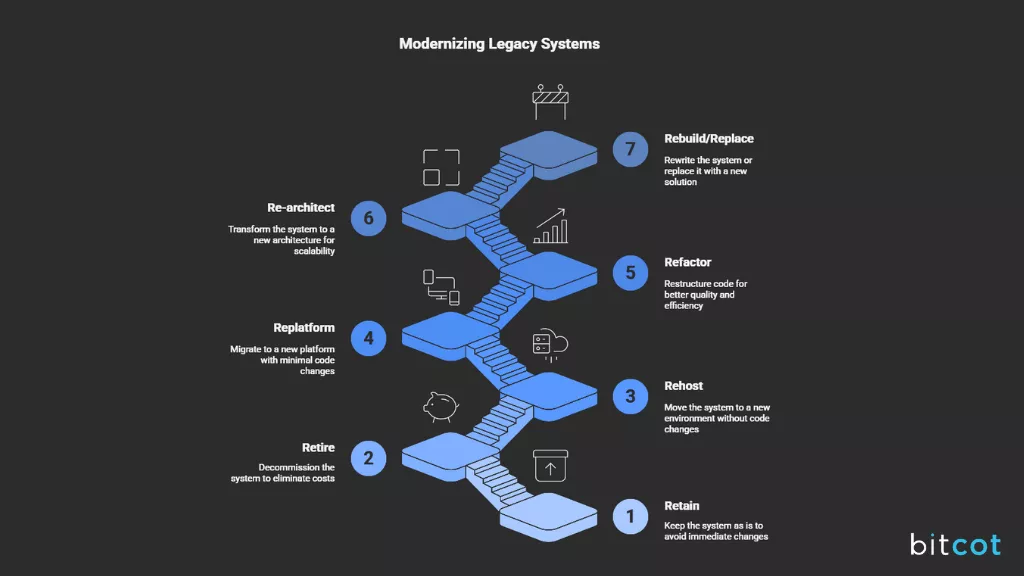
Moving from the “why” and the “what” (examples) to the “how” (strategies) is crucial.
A successful modernization effort hinges on a well-defined strategy that aligns technical feasibility with clear business goals. Whether you’re a startup in San Francisco or an established enterprise in San Jose, understanding these strategies is essential for successful transformation.
Here are some key legacy system modernization strategies:
The 7 R’s: Choosing Your Modernization Path
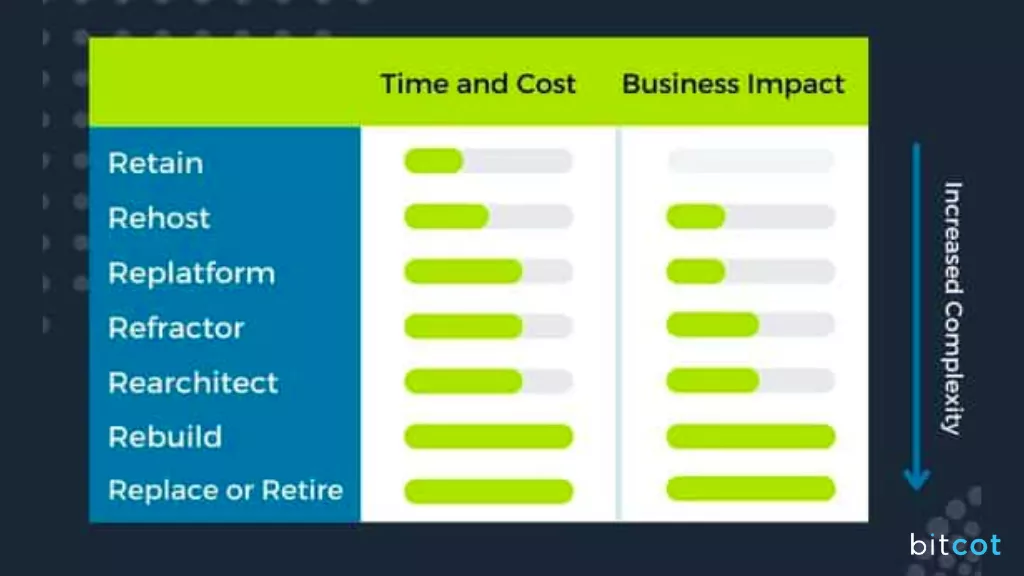
Before any code is written, you must assess the legacy system and select the right strategy. The industry typically categorizes these legacy system modernization approaches into “The 7 R’s” (or R-Strategies).
| Strategy (The R) | Description | Key Business Driver | Risk/Cost |
| 1. Retain | Keep the application as is; no changes are made. | High regulatory/business risk in making changes. | Low immediate cost, high long-term maintenance risk. |
| 2. Retire | Decommission the application and eliminate associated maintenance costs. | Functionality is redundant or no longer needed. | Low (with a proper data archive plan). |
| 3. Rehost (Lift & Shift) | Move the application to a new physical or virtual environment (often the cloud) without changing code. | Quick wins in infrastructure cost/scalability. | Low risk, but limits cloud-native cost savings. |
| 4. Replatform | Move to a new platform and make minimal code changes to integrate new platform features (e.g., migrating a database to a managed cloud service). | Leverage specific new environment features (like PaaS). | Moderate cost, moderate business value. |
| 5. Refactor | Restructure and optimize the existing code without altering its external functionality. | Improve code quality, maintainability, and efficiency. | High technical skill required, high value. |
| 6. Re-architect | Significantly modify the application’s code to shift it to a new architecture (e.g., Monolith to Microservices). | Achieve high-level scalability, agility, and resilience. | High risk, highest long-term business value. |
| 7. Rebuild/Replace | Rewrite the application from scratch or purchase a new commercial off-the-shelf (COTS) solution. | When the legacy code is irreparable, or COTS is cheaper. | Highest risk and cost, but potentially the best long-term fit. |
Key Patterns for Incremental Success
The primary best practice across nearly all successful projects is to avoid the “Big Bang” failure (as noted in the failure legacy system modernization case study) by adopting an evolutionary, incremental approach.
1. The Strangler Fig Pattern (The De-risking Strategy)
This is the gold standard for gradually replacing core systems.
- How it Works: You build new components (microservices) alongside the old legacy system. An API Gateway acts as a traffic manager, routing new requests to the new components and legacy requests to the old system. Over time, the new system “strangles” the old one by taking over more and more functionality until the legacy system can finally be decommissioned.
- Best for: Mission-critical, monolithic applications (like core banking or ERP).
- Value: It minimizes risk by allowing you to test, validate, and roll back new features without disrupting the existing business-critical function.
2. Encapsulation via APIs (The Quick Win Strategy)
This is often the first step in modernization.
- How it Works: You create a modern layer of APIs (Application Programming Interfaces) around the legacy application, making the legacy system’s functions and data accessible to modern systems (web, mobile, analytics) without changing the core code.
- Best for: Systems with high functional value but poor integration capabilities.
- Value: Provides immediate value by unlocking trapped data for new use cases (e.g., exposing mainframe data to a new customer mobile app).
3. Data First, Application Second
Data is the most critical asset. If the data architecture is a mess, the new application will fail.
- How it Works: Modernize the data layer before or in parallel with the application layer. This often involves migrating data to a modern cloud database, cleaning and normalizing it, and implementing an Anti-Corruption Layer (ACL), a translation layer that ensures the new system’s clean data structure isn’t polluted by the legacy system’s quirks.
- Best for: Systems where data quality, synchronization, and security are paramount (e.g., healthcare, financial trading).
- Value: Ensures data integrity and consistency, which is fundamental for any modern application.
Essential Best Practices for Execution
Beyond the technical strategy, success depends on people and process.
| Best Practice Area | Actionable Steps | Why It Matters |
| 1. Strategic Alignment | Define Clear Business Outcomes: Modernize to reduce time-to-market by 30% or cut infrastructure costs by 40%, not just to use “the cloud.” | Ensures executive buy-in and provides measurable ROI. |
| 2. Risk Mitigation | Automated Testing & Parallel Runs: Develop comprehensive test suites for the legacy system first. Run the old and new systems in parallel for a period to validate results before the final cutover. | Prevents catastrophic outages and verifies that the new system behaves identically to the old one, where required. |
| 3. Process & Culture | Adopt DevOps & CI/CD: Implement Continuous Integration/Continuous Deployment (CI/CD) from day one.
Upskill/Reskill Teams: Invest in training for modern cloud, microservices, and security practices. |
Delivers features faster, automates risk, and turns former “legacy maintainers” into “innovation builders.” |
| 4. Cost Management | Right-Size Cloud Resources: After Rehosting, immediately begin Replatforming/Refactoring to leverage serverless or managed services. Don’t pay cloud rates for an inefficient, monolithic architecture. | This is the key difference between the successful and the over-budget cloud migration. |
By meticulously planning the transition using the appropriate “R” strategies and focusing on incremental, de-risked delivery, organizations across California, from tech companies in Oakland to logistics firms in Stockton, can successfully leverage their legacy investments while building a flexible, future-proof digital core.
Understanding the Process of Modernizing Legacy Systems
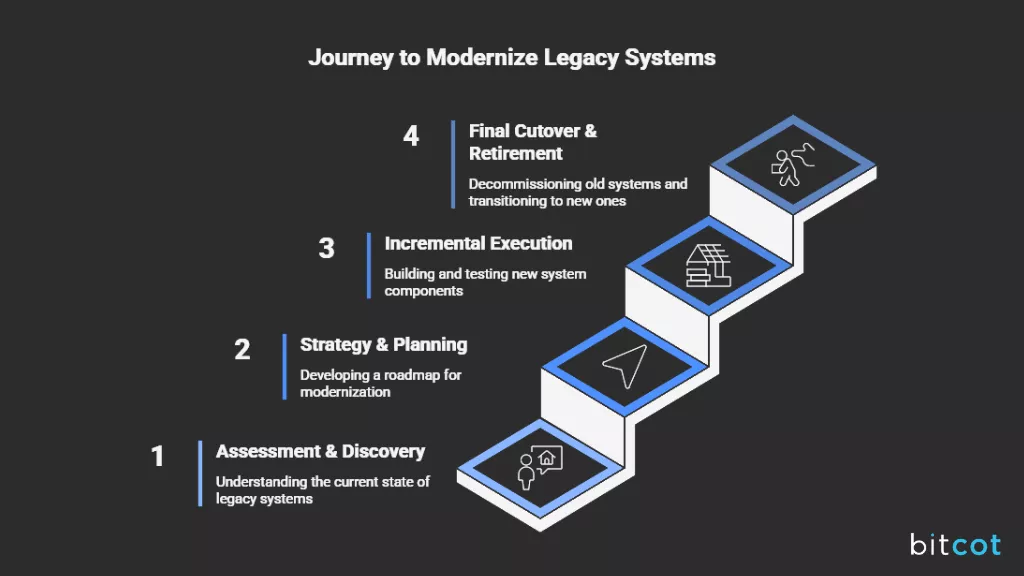
Modernization is a structured, multi-phase journey designed to systematically replace or enhance legacy systems while maintaining business continuity.
Adopting a structured lifecycle is key to mitigating risk, controlling costs, and ensuring the technical efforts align with strategic business goals.
Phase 1: Assessment and Discovery (The “Know Thyself” Phase)
This initial phase is all about objective data gathering and strategic alignment. You cannot fix what you do not fully understand.
- Application Portfolio Audit: Start by creating a comprehensive inventory. Document every application, database, and hardware component. Critically, perform dependency mapping (often requiring specialized tools) to identify how applications communicate and rely on each other.
- Technical & Business Evaluation:
- Technical Health: Analyze the code quality, language version obsolescence, and architectural fragility (e.g., how brittle the system is to change). This results in a measure of technical debt.
- Business Value: Evaluate each system’s criticality to core business functions, revenue generation, and regulatory compliance.
- Stakeholder Alignment: Conduct interviews with all users, from frontline staff to executives. The goal is to identify daily frustrations (workarounds) and define precise, measurable Success Metrics that align with business outcomes (e.g., “Reduce monthly downtime from 12 hours to 1 hour”).
The primary output of this phase is a System Health Scorecard and a clear set of prioritized Modernization Goals.
Phase 2: Strategy and Planning (The “Roadmap” Phase)
In this phase, you translate the assessed needs into a detailed, executable plan.
- Prioritization and Strategy Selection: Review the systems identified in Phase 1 and prioritize them based on risk and value. Assign one of the 7 R’s (Retain, Retire, Rehost, Replatform, Refactor, Rearchitect, or Rebuild/Replace) to each application. Crucially, avoid the single “Big Bang” strategy; instead, choose a low-risk, incremental pattern like the Strangler Fig Pattern.
- Target Architecture Design: Define the future state. This involves selecting the modern technologies (e.g., cloud platform, containerization, microservices) and designing how the new system will be architected.
- Roadmap Development: Create a phased, multi-year plan. The roadmap sequences the work into manageable iterations, identifying milestones, resources, and budget allocations. This plan should dictate which component is tackled in which quarter to maintain business stability. Organizations in Riverside and Fremont often benefit from phased approaches.
- DevOps and Tooling Setup: Establish the necessary processes and infrastructure for continuous delivery. This includes setting up the CI/CD pipelines and comprehensive automated testing frameworks that will run checks against the new code.
Phase 3: Incremental Execution (The “Build and Test” Phase)
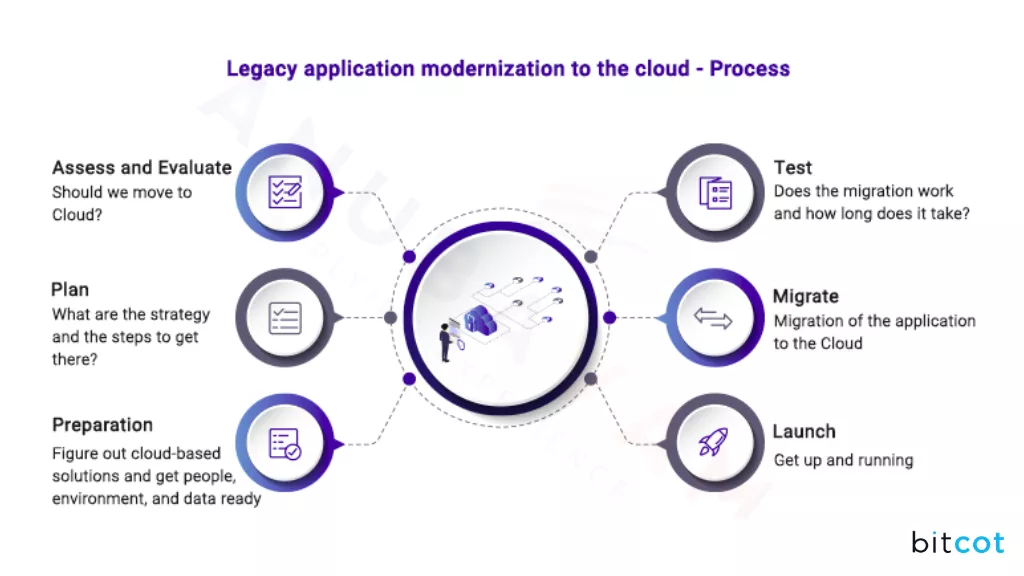
This phase is the iterative development work, focusing on deploying new features and safely isolating them from the old system.
- Foundation and Proxy Deployment: Set up the initial target environment (e.g., the cloud VPC). Deploy the central API Gateway or Strangler Fig Proxy that will manage traffic flow between the old system and the new components.
- Module-by-Module Migration: Select a single, manageable function of the legacy system to replace (e.g., the customer lookup function).
- Develop the new service as an independent microservice.
- Implement Encapsulation by creating an API that allows the new service to read/write data to the old system’s database.
- Rigorous Parallel Validation: This is the most critical risk mitigation step.
- Use Dark Launching to send copies of live production traffic to the new service to validate its behavior and performance without impacting actual users.
- Run the new and old systems in parallel until the new component achieves functional parity and stability.
- Gradual Cutover: Once validated, use Feature Toggles or the traffic proxy to gradually shift live user requests to the new service. The immediate ability to roll back to the old system is maintained during this transition.
Phase 4: Final Cutover and Retirement (The “Decommission” Phase)
The final phase involves eliminating the last vestiges of the legacy system to realize full cost savings and operational freedom.
- Final Data Migration and Archival: Migrate any remaining operational data to the new production system. Crucially, move all historical, non-operational data to a secure, lower-cost archival platform for compliance purposes.
- Legacy System Decommission: Once all traffic has been confirmed as running through the new components and the data is secured, the legacy application and its associated physical hardware or virtual instances are shut down and retired. This eliminates the maintenance and licensing cost sink.
- Continuous Optimization: Modernization is ongoing. Continuously monitor the new system’s performance, cloud spend, and user feedback. Integrate the new, modern way of working (DevOps, Agile) into the organization’s culture to prevent future technical debt.
Following a structured process reduces risks, controls costs, and maximizes the benefits of modernization. By approaching legacy system modernization in these stages, organizations throughout California, USA, from Santa Ana to Bakersfield and beyond, can transform outdated infrastructure into agile, secure, and efficient platforms that support growth and innovation.
Key Services Offered in Legacy System Modernization Projects
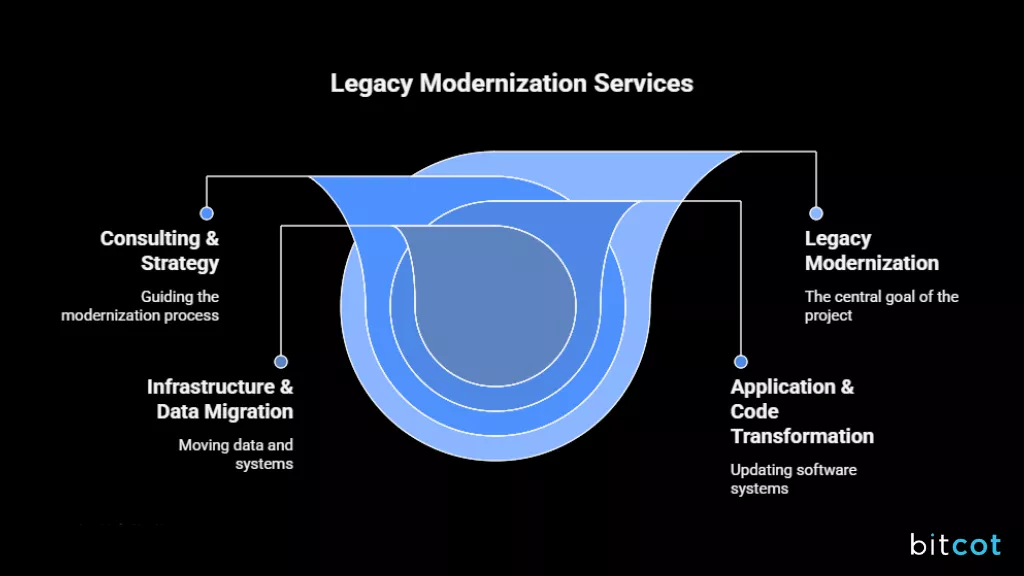
Legacy modernization is a complex undertaking that requires specialized expertise across business strategy, architecture, and engineering. Organizations often rely on a combination of internal teams and external partners to cover the breadth of necessary services.
The key services fall into three main categories: Consulting & Strategy, Application & Code Transformation, and Infrastructure & Data Migration.
1. Consulting and Strategy Services
These services are foundational, ensuring the project aligns with long-term business goals and minimizes financial and operational risk.
- Application Portfolio Assessment (Audit): The first step in any project. This involves:
- Technical Audit: Analyzing code base quality, dependencies, architecture, and technology stack versions (e.g., COBOL, old Java, Mainframe).
- Business Valuation: Determining the business criticality, total cost of ownership (TCO), and innovation barriers posed by each system.
- Modernization Roadmap Development: Creating a structured plan for the entire journey. This service defines the scope, selects the appropriate “R” strategy (Rehost, Re-architect, etc.) for each application, and sequences the migration (e.g., using the Strangler Fig Pattern) over time.
- Business Process Re-engineering (BPR): Modernization is the perfect time to optimize old, inefficient workflows. BPR service analyzes and redesigns business processes before they are coded into the new system, ensuring the modernized application eliminates unnecessary steps.
- Risk and Compliance Management: Identifying and mitigating security vulnerabilities, ensuring the new architecture adheres to modern regulatory standards (e.g., GDPR, HIPAA), and establishing security practices (DevSecOps) from the outset.
2. Application and Code Transformation Services
These are the core engineering services that directly change the software itself.
- Code Refactoring and Re-engineering:
- Refactoring: Optimizing and restructuring the existing legacy code to improve maintainability and performance without changing its external behavior.
- Re-engineering: Substantially rewriting code in a modern language (e.g., converting old Visual Basic to C# or COBOL to Java) while preserving the proven business logic.
- Architecture Modernization (Monolith to Microservices): The critical service for achieving agility. It involves breaking down a large, tightly-coupled monolithic application into smaller, independent, loosely-coupled services that can be developed and deployed individually.
- API Enablement and Encapsulation: Creating a standardized layer of APIs around a legacy application. This is essential for unlocking the legacy system’s core functions and data, allowing modern web and mobile apps to interact with it seamlessly.
- UI/UX Modernization: Redesigning the application’s user interface and user experience. This service is often a “quick win” (Refacing) that significantly improves employee productivity and customer satisfaction, even if the backend remains legacy (temporarily).
- Sector-Specific Transformation: Dedicated engineering for niche or highly regulated systems, including insurance legacy system transformation for core policy and claims platforms, and legacy control system upgrades for updating proprietary operational technology (OT).
3. Infrastructure and Data Migration Services
These services handle the physical movement of the application and its critical data to a modern, scalable environment.
- Cloud Migration Services (Rehosting/Replatforming):
- Lift and Shift (Rehosting): Moving the application to a cloud provider (AWS, Azure, GCP) with minimal changes for quick infrastructure cost savings.
- Cloud-Native Replatforming: Modifying the application to leverage managed cloud services (e.g., using containers like Docker/Kubernetes) to gain better scalability and resilience.
- Data Modernization and Migration: The most delicate part of the project.
- Data Audit and Cleansing: Identifying redundant, inaccurate, or fragmented data.
- Database Migration: Moving data from legacy database systems (e.g., Mainframe files, old proprietary databases) to modern, scalable systems (e.g., PostgreSQL, NoSQL).
- Synchronization: Implementing tools (like Change Data Capture) to keep the old and new databases synchronized during the transition period.
- This also includes specialized legacy system data transfer for modern startups to integrate acquired data with agile platforms.
- DevOps Implementation and Automation: Setting up the tools and culture needed for modern software delivery. This includes automating infrastructure provisioning (Infrastructure as Code), deployment, and monitoring to ensure rapid, high-quality releases.
Cost Overview of Legacy System Modernization and Migration
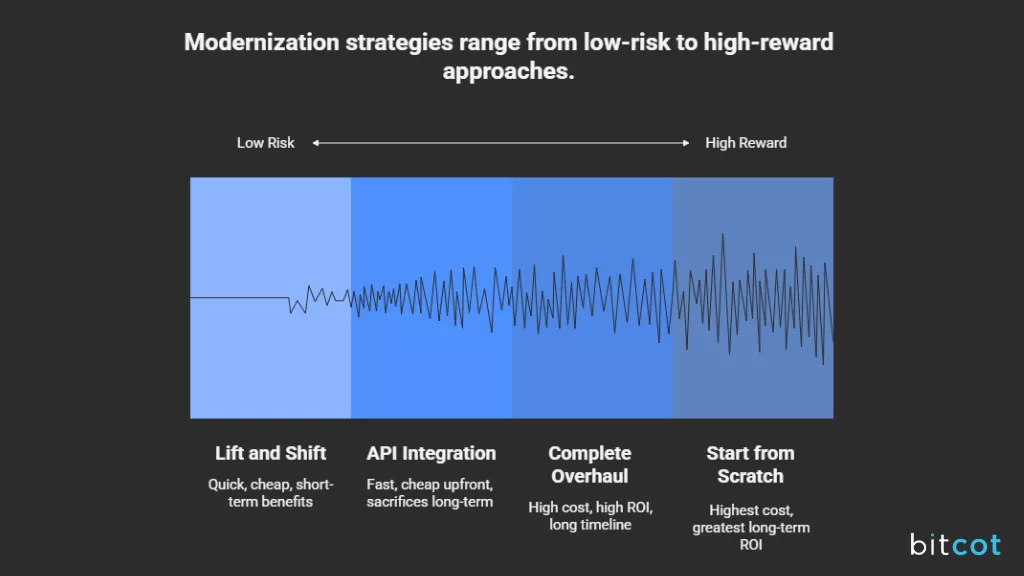
The decision to modernize is fundamentally a financial one: is the cost of the project justifiable against the high and rising costs of inaction?
A true cost analysis must consider both the explicit expenses of the project and the hidden financial drain of the legacy system itself.
Part 1: The High and Hidden Costs of the Legacy System (Cost of Inaction)
Organizations often underestimate the true Total Cost of Ownership (TCO) of a legacy system, as most of the cost is subtle, yet continuous.
Direct Operational Costs (The Visible Drain):
- Maintenance & Licensing: Allocating a disproportionate share of the IT budget (often 60% to 80%) simply to “keeping the lights on.” This includes exorbitant vendor support contracts, premium licensing fees (e.g., to continue using unsupported software), and expensive custom patches.
- Specialized Talent: The cost of hiring, training, and retaining developers skilled in obsolete languages (like COBOL, Assembler, or old proprietary platforms) is constantly rising as the talent pool shrinks. This is particularly challenging for businesses in Anaheim and Chula Vista competing for limited specialized talent.
- Inefficient Infrastructure: Older systems consume more energy, require more physical space, and are often grossly underutilized. This results in higher utility bills and under-optimized hardware spending.
Indirect Opportunity Costs (The Hidden Drain):
- Productivity Loss: Employees spend significant time on manual workarounds, waiting for slow systems, and dealing with frequent crashes. This time is lost revenue and wasted salary (e.g., losing hours per day per employee).
- Security & Compliance Risk: Legacy systems lack modern security features, making them prime targets. The global average cost of a data breach is in the millions of dollars, and non-compliance with regulations (HIPAA, GDPR) results in massive fines.
- Innovation Paralysis: The system’s rigidity prevents the adoption of modern technologies (Cloud, AI/ML). Competitors move faster, leading to lost market share and missed revenue opportunities. Businesses across California and the USA cannot afford to fall behind.
- Technical Debt Accrual: Every custom workaround and hurried patch adds to technical debt, making future changes exponentially more expensive and time-consuming.
Part 2: Factors Determining Modernization Project Cost
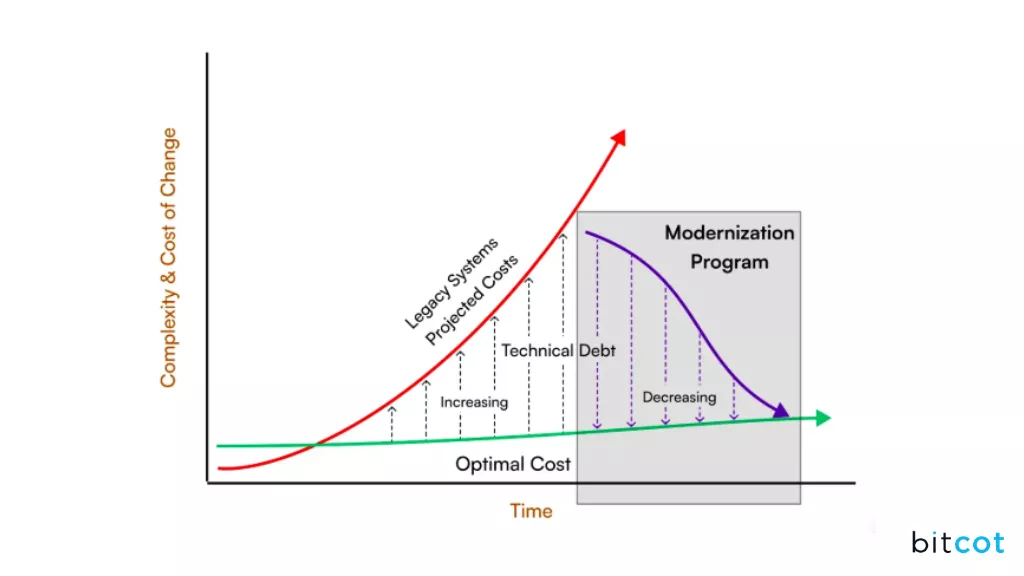
The budget for a modernization project varies drastically based on the chosen legacy system migration strategy and the system’s complexity. These are the primary cost drivers:
1. Complexity and Size of the Legacy System:
- The total lines of code and the number of integration points (dependencies) are the largest cost factors. The more complex the system, the more costly the Assessment, Refactoring, and Testing phases will be.
- A Monolith is more expensive to re-architect than a smaller, isolated application is to simply Rehost.
2. The Chosen Modernization Strategy (The R’s):
- Low Cost/Low Risk: Rehost (Lift and Shift) or Encapsulation (APIs) are fast and cheap upfront, but sacrifice long-term benefits.
- High Cost/High Value: Re-architecting or Rebuilding provides the greatest long-term ROI but carries the highest upfront development cost and longest timeline.
3. Data Migration Effort:
- The volume of data and the complexity of its structure determine cost. Moving data from a proprietary legacy format to a modern SQL/NoSQL cloud database requires extensive Data Cleansing, Transformation, and Validation.
4. Talent and Skills Gap:
- If internal teams lack experience with the target architecture (e.g., Microservices, Kubernetes), the cost shifts to expensive external consulting, training, and specialized contracting rates.
5. Testing and Transition Time:
- Rigorous Parallel Testing (running old and new systems simultaneously) is mandatory to mitigate risk, but requires maintaining two full environments, doubling infrastructure costs during the cutover period.
Part 3: Calculating the Return on Investment (ROI)
The goal of modernization is not just to replace the old system, but to achieve a positive ROI over a defined period (typically 3-5 years).
| Component | Impact on ROI Calculation |
| Total Gains (Benefits) | Quantified Savings: Reduced maintenance budget, eliminated licensing fees, lower cloud hosting costs (post-optimization).
Revenue & Productivity: Increased employee efficiency, faster time-to-market for new features, lower security breach costs. |
| Total Costs (Investment) | Direct Project Costs: Consulting, development, data migration, new infrastructure/platform setup, and employee training.
Transition Costs: Running parallel systems and managing data synchronization during cutover. |
A strong business case for modernization proves that the rising TCO curve of the legacy system will eventually cross the development cost line, leading to long-term financial stability and operational agility.
Partner with Bitcot to Modernize Your Legacy Systems
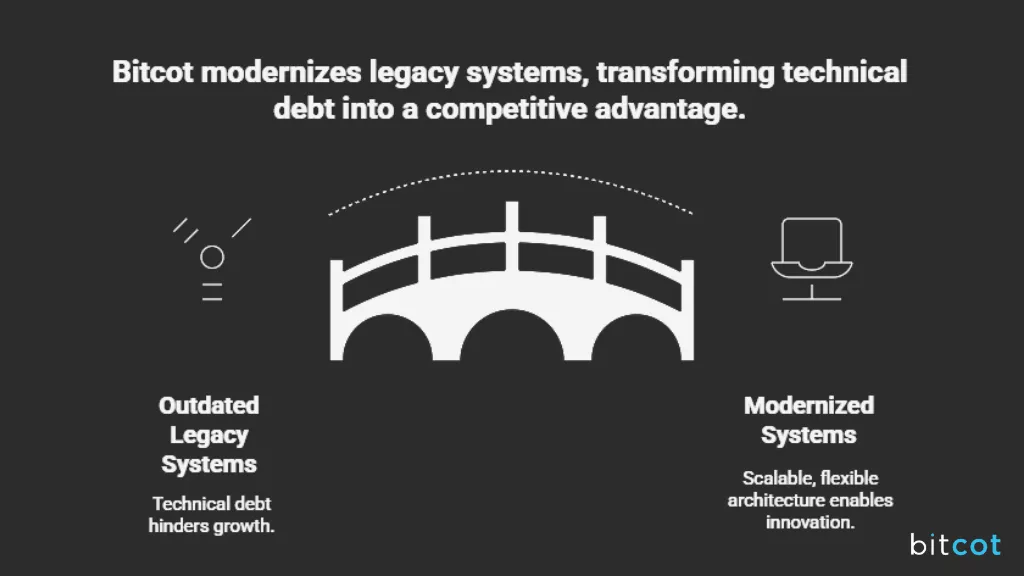
Modernizing a legacy system is complex, and the right partner can make or break the project.
Don’t let outdated technology be an anchor on your future growth. Bitcot offers comprehensive legacy system modernization services to guide your business through the complexities of legacy modernization, turning technical debt into a competitive advantage. We focus on strategic, incremental transformations that deliver continuous business value with minimized risk.
Whether you’re based in Los Angeles, San Francisco, San Diego, or any of California’s major business hubs including San Jose, Fresno, Sacramento, Long Beach, Oakland, Bakersaki, Anaheim, Stockton, Irvine, Riverside, Chula Vista, Fremont, or Santa Ana, our team has the expertise to support your digital transformation journey across California, USA.
Here’s why Bitcot is uniquely positioned to deliver successful, future-ready modernization:
- Proven track record across industries: Bitcot has successfully modernized legacy systems for finance, healthcare, retail, manufacturing, and NPOs, delivering measurable results every time.
- Deep expertise in both legacy and modern technologies: Unlike typical providers, we handle legacy systems built in COBOL, .NET, Java, PHP, and outdated databases while seamlessly integrating them with cloud-native platforms, APIs, and modern architectures.
- Tailored strategies, not templates: We don’t force one-size-fits-all solutions. Every modernization plan and legacy system integration is customized to your business goals, workflows, and technical constraints.
- Focus on minimizing business disruption: Bitcot specializes in phased modernization, ensuring your operations continue smoothly while critical systems are updated.
- Integrated security and compliance expertise: We proactively address vulnerabilities and ensure adherence to HIPAA, PCI-DSS, SOC2, GDPR, and industry-specific regulations throughout the modernization process.
- End-to-end modernization capability: From system assessment and refactoring to cloud migration, UI/UX redesign, data migration, and ongoing support, we handle the entire lifecycle under one roof.
- Agility and future-proofing: We don’t just modernize systems for today; we design scalable, flexible architectures that allow your business to innovate and grow without repeated costly overhauls.
- Business-first mindset: Our team collaborates closely with leadership, IT, and operations to ensure that modernization aligns with ROI, operational efficiency, and long-term strategic goals, not just technical upgrades.
- Dedicated post-implementation support: Many providers hand over the system and leave; Bitcot stays with you, providing monitoring, performance optimization, and iterative improvements to ensure lasting value.
Choosing Bitcot means working with a partner who understands both the technical and business challenges of legacy system modernization and delivers legacy system migration services that are safe, strategic, and tailored to your organization.
Final Thoughts
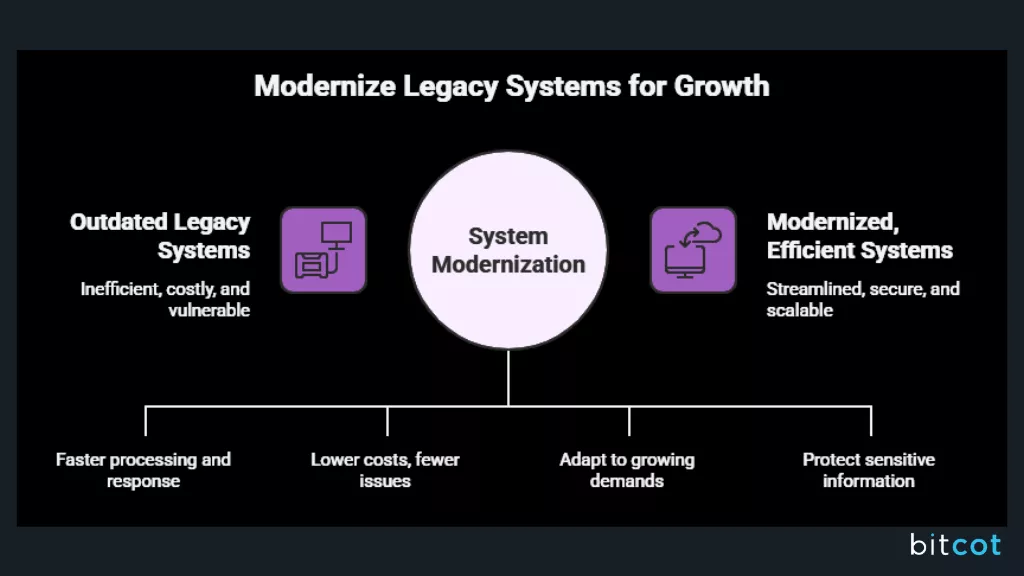
Modernizing a legacy system isn’t just about upgrading software; it’s about transforming the way your business operates.
Outdated systems can slow you down, frustrate your team, and make it hard to keep up with customers’ expectations. At the same time, modernization isn’t just a tech project; it’s a chance to rethink processes, improve efficiency, and set your business up for growth.
The journey can feel overwhelming, and it’s easy to get lost in technical jargon or endless options. But when done right, modernization unlocks real, tangible benefits: faster workflows, better collaboration, secure and compliant systems, and technology that actually works for your team rather than against them.
Companies that embrace modernization don’t just survive; they gain the agility to innovate, the insights to make smarter decisions, and the foundation to scale confidently.
It’s also worth remembering that there’s no one-size-fits-all solution. Every business has its own challenges, goals, and existing technology stack. The key is a partner who understands your unique needs, guides you through each step, and ensures that modernization delivers value without unnecessary risk or disruption.
Done thoughtfully, modernizing your legacy systems isn’t a burden; it’s an opportunity. An opportunity to reduce costs, increase efficiency, enhance security, and position your business for the future.
Take the next step with Bitcot and transform your systems through our custom enterprise software development services.
Get in touch with our team.



